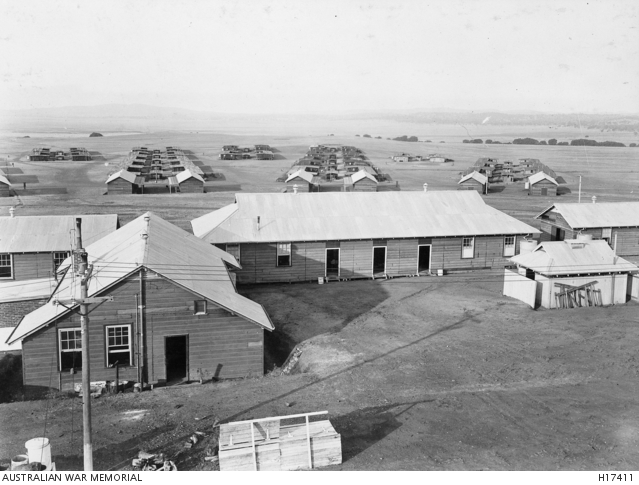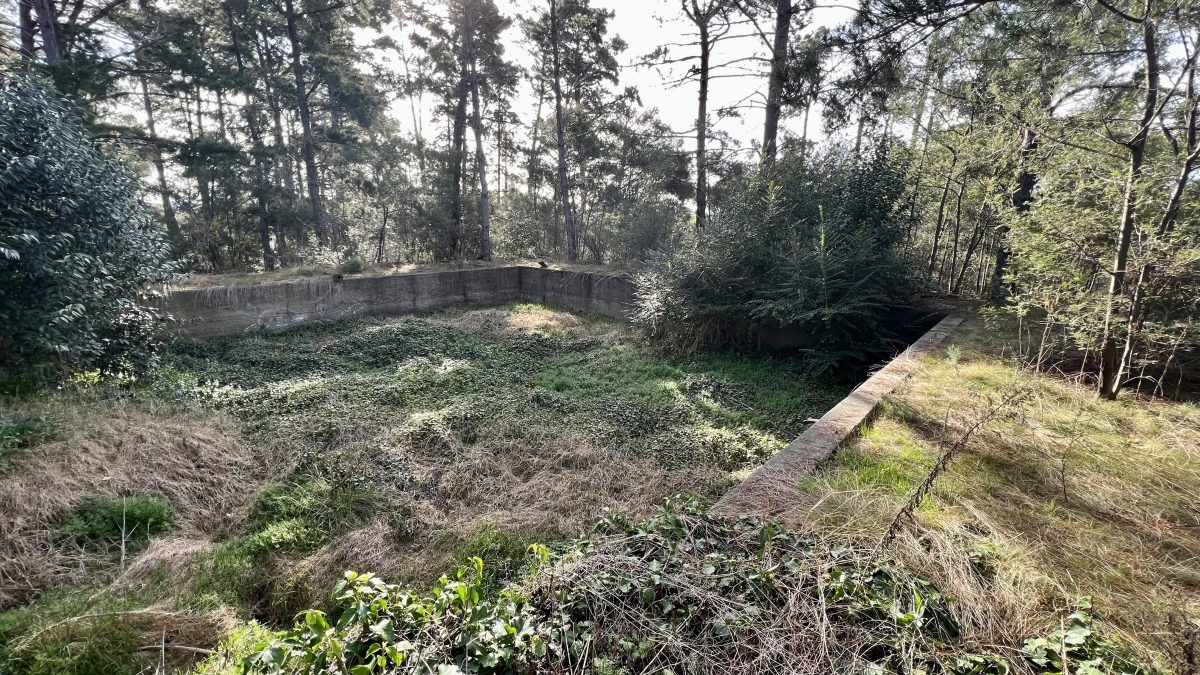
The water reservoir for the Molonglo Internment Camp, behind BCF and Anytime Fitness in Fyshwick. Photo: James Coleman.
Tucked away in the pine trees off Newcastle Street in Fyshwick is what appears to be an abandoned swimming pool. The reality is much more shocking – it’s an old water reservoir for a World-War-I-era concentration camp that was spread out where the ACT’s industrial suburb lies today.
The preferred name is “Molonglo Internment Camp” but stamp collectors will tell you that the on-site post office marked letters with an ink stamp that actually read “Molonglo Concentration Camp”. The soldiers in charge were known as the “Molonglo Concentration Camp Guard”.
Canberra historian Mark Butz says the name might send a shiver down the spine, but all it referred to was “enemy aliens concentrated in one place”.
Either way, what was it all about?
“It’s a fairly simple story,” Mark begins.
In 1917, China finally decided to end its neutrality and enter World War I on the side of the Allies. This meant those of German or Austrian descent were no longer welcome in China and so on their new ally’s behalf, Britain asked nearby Australia to provide an internment camp big enough to accommodate about 3500 people.

The view from the watchtower at the Molonglo Internment Camp. Photo: Public domain, Australian War Memorial.
“This was the first war Australia had experienced as one country, so there was a strong sense we as a nation should do something to help and if we did that, we should do it in the Federal Capital Territory,” Mark says.
So a site was set aside on the eastern side of the Territory, near Queanbeyan, and all 160 buildings were erected within ten weeks.
“It was built in extremely record time,” Mark says.
“But it was a very big military secret, despite the fact it was on the main road to Queanbeyan and there were more than 1000 workers camped in tents there. Nobody would own up to what it was.”
It sat on the site set aside by Walter Burley Griffin for his prestige suburb of Lake Park, but he didn’t mind. He knew it would help clear the land.
“A watchtower, with associated administration and military buildings, was located on a gravel ridge where Molonglo Mall is today, while the tenement buildings were radiating out like spokes on a wheel,” Mark says.

The camp’s post office. Photo: National Archives of Australia.
The camp was open for business by April 1917, but shortly before it was to receive its first group of detainees from China, high-level political negotiations curtailed the plan.
“They ended up taking people from internment camps in Bourke and Berrima in NSW,” Mark says.
“So by the middle of 1918, they ended up with a grand total of 300 people, for a camp designed to take 3500.”
Many of these had been rounded up in the German colonies in the Pacific such as Singapore and even Hong Kong and then taken to Australia, but when WWI came to a close six months later, the country of origin didn’t seem to matter.
“The mind boggles at this today, but no matter where they had come from, Australia decided it was Germany’s problem now, so everyone from this camp was sent to Germany, even though many of them had never been there.”
As for life in the camp itself, Mark says it was “very civilised”.
“It had its own school, library, theatre and community garden – all run by the detainees themselves.”
There were fences all around so people couldn’t come and go and it was connected to electricity from the Kingston power house so the whole area could be floodlit at night, but “they were allowed to get down to the Molonglo River sometimes, under supervision”.

The sign for the Molonglo Internment Camp at Molonglo Mall. Photo: James Coleman.
Once all the detainees were gone, almost all of the demountable buildings were sold off while those that remained became part of the Molonglo Workers Settlement for those involved in the construction of the new city.
“By the mid-1920s, this was the largest concentration of people in the Territory,” Mark says.
Within 30 years, Griffin’s Lake Park had vapourised and the new city planners had decided the industrial part of town had to move out of Kingston. By the 1980s, the place had been razed to make way for Fyshwick.

The bottom of the reservoir is completely overgrown today. Photo: James Coleman.
Mark says many people have tried their utmost to track down where all the buildings went, without much luck.
“Some went to Duntroon, others to schools such as Narrabundah College, and a cottage to Weetangera School. They got scattered around,” he says.
The only remaining relic is the water reservoir, sitting among the pine trees and overgrown with weeds.
“Whenever I’m up there doing tours, people are gobsmacked that such a thing as this ever existed in Canberra,” Mark says.












